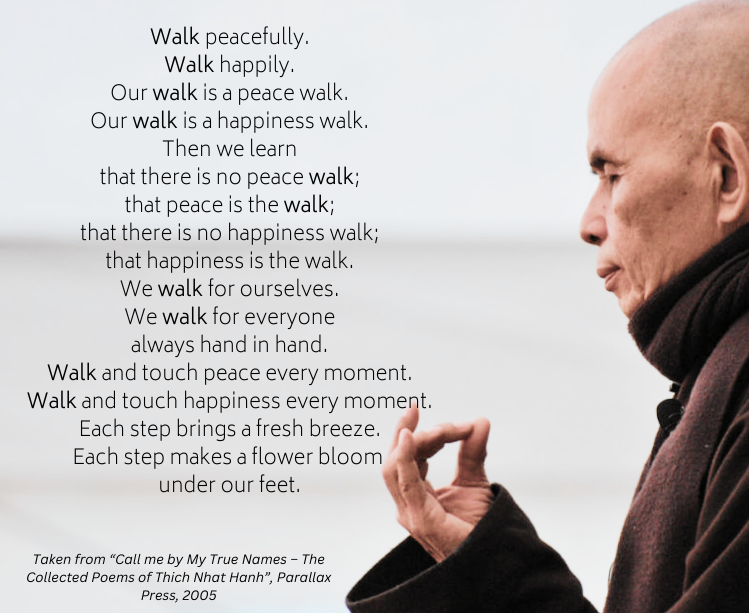Walking Meditation for Daily Life: How Can It Improve Your Physical and Mental Wellness

The practice of mindful walking and walking meditation offers a beautiful opportunity to integrate mindfulness into your daily life. Combining the benefits of physical exercise with mental well-being, these practices have profound effects on our health and overall sense of inner peace.
Origin of walking meditation
Walking meditation is a form of mindfulness practice with its roots in Buddhism. It is often used as an alternative or complementary practice to seated meditation. Like other mindfulness practices, walking meditation aims to cultivate present-moment awareness and a deep connection to the surrounding environment.

In Buddhism, walking meditation is known as "kinhin" in Japanese and "cankama" in Pali (an ancient Indian language). It is typically practiced as a formal exercise within the context of meditation retreats or as part of a daily routine in monasteries.
The Art of Walking Mediation
Walking meditation can be practiced anywhere, indoors or outdoors, and does not require any special equipment. However, when doing this, you need to walk slowly and deliberately, paying close attention to the sensations of each step. The focus is on the act of walking itself, including the lifting, moving, and placing of the feet. If the mind wanders, the practitioner gently redirects their attention back to the walking process. While, to experience its full benefits, it's essential to approach it with an open and non-judgmental attitude, just as with any mindfulness practice.
Surprising Benefits of Mindful Walking
For individuals who find seated meditation challenging or uncomfortable, walking meditation provides a different way to engage in mindfulness practice. It is effective for several physical, mental, and emotional issues. It helps in grounding oneself in the present moment, just like other mindfulness techniques, fostering a sense of stability and tranquility;
Stress Reduction
Mindful walking helps reduce stress and anxiety by allowing you to focus on the present moment and detach from worrying thoughts or future concerns.
Related Read: Anti-Stress Foods: Eat To Beat Stress & Anxiety Naturally
Improved Concentration
This practice enhances concentration and mental clarity, as you become fully engaged in the act of walking and observing your surroundings.
Enhanced Mind-Body Connection
By paying attention to the sensations in your body while walking, you strengthen the connection between your mind and body, fostering a greater sense of self-awareness.
Increased Physical Awareness
Mindful walking encourages you to notice your posture, breath, and the way your body moves, promoting better body alignment and overall physical awareness.
Cervical Pillow: Say Goodbye To Neck Pain Brought On Due To Incorrect Sleeping Posture
Connection with Nature
When practicing mindful walking outdoors, you can connect with nature and appreciate the beauty of your surroundings more deeply.
Mood Enhancement
Engaging in mindful walking can boost your mood and even help alleviate symptoms of mild depression by bringing your focus to positive experiences and sensations.
Mindful Exercise
It provides an opportunity to integrate mindfulness into your daily routine and combine the benefits of physical activity with mental well-being.
Stress-Free Fitness
Unlike intense workouts, mindful walking is a low-impact activity accessible to people of all fitness levels and ages.
Tip #1
Consider finding a peaceful environment, walking at a comfortable pace, and consciously focusing on your breath and steps to experience the full benefits of mindful walking. Create a serene atmosphere by finding a tranquil setting, where you can walk at a leisurely pace and immerse yourself in the calming effects of mindful walking.
Time for Reflection
Mindful walking offers a chance to take a break from the fast-paced world and create moments of introspection and self-discovery.
Fitness Tracker: A Perfect Walk Meditation Companion
Fitness trackers can indeed be great tools for practicing mindful walking. They provide valuable data and feedback that can enhance your awareness and help you stay focused during your walking meditation sessions. You just need to wear the tracker comfortably on your wrist with goal setting. While goal setting might encourage you move faster, but don’t get too fixated on the numbers instead, use the data as a gentle reminder to stay focused and present during your walk. Maintain a gentle and comfortable pace throughout your practice. You can check data like the number of steps taken, distance covered, heart rate, and other relevant metrics.
If you are looking for a simple wearable that can push notifications from your smartphone, Dr Trust Fitness Tracker is an undeniably impressive fitness tracker. It is one of the nicest-looking fitness trackers which comes with all advanced tracking features and a high quality display. It engages your senses fully for making your mindfulness practice more engaging and insightful. Its simple set up and advanced features make it an excellent choice for users.
Remember, whether you walk in a park, on the beach, or simply around your neighborhood, star walking mindfully as it can be a powerful addition to your daily routine. Remember that the ultimate goal of walk meditation is to be present in the moment and cultivate mindfulness in your daily life. Enjoy your meditative walk!
